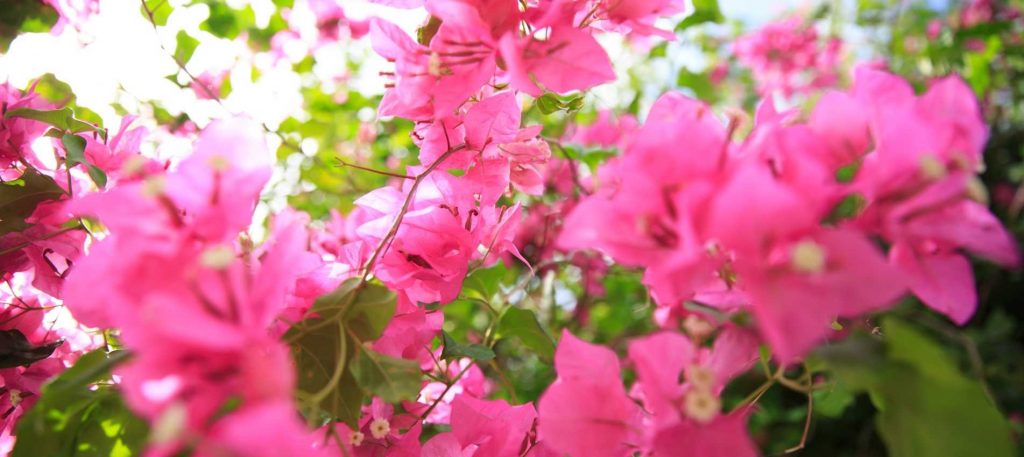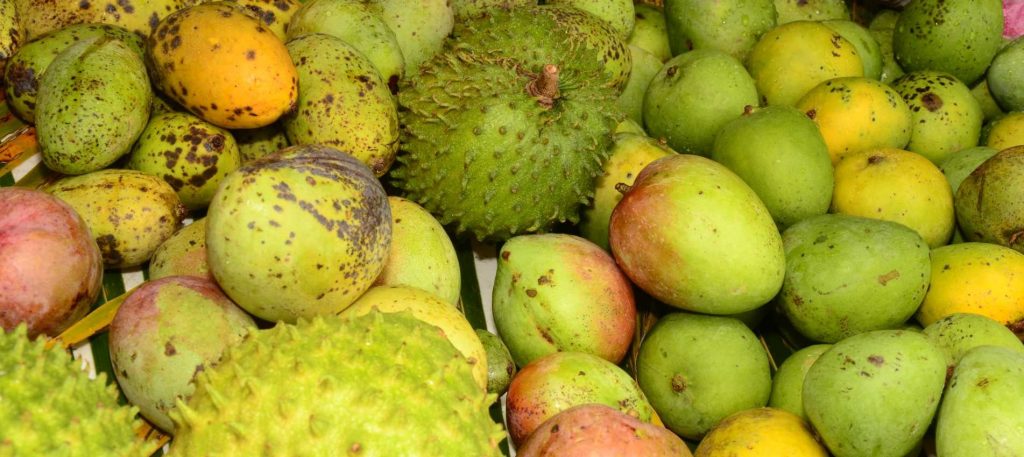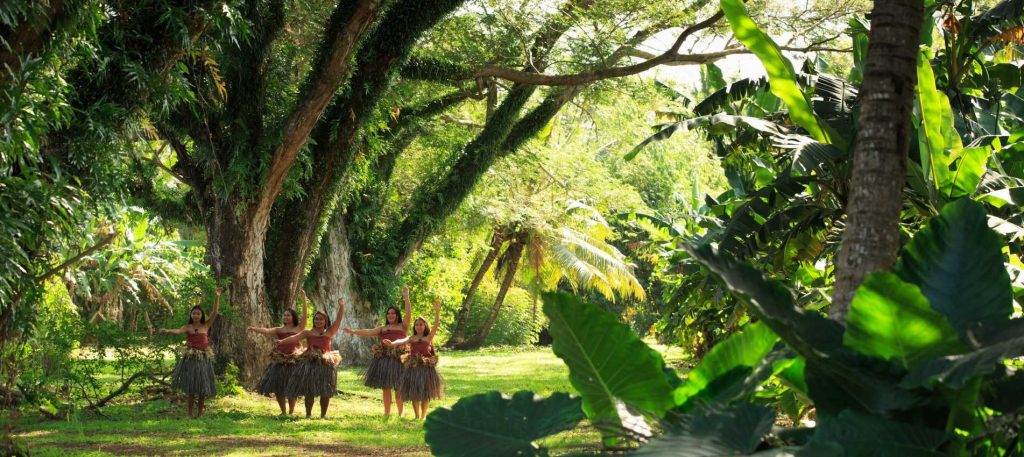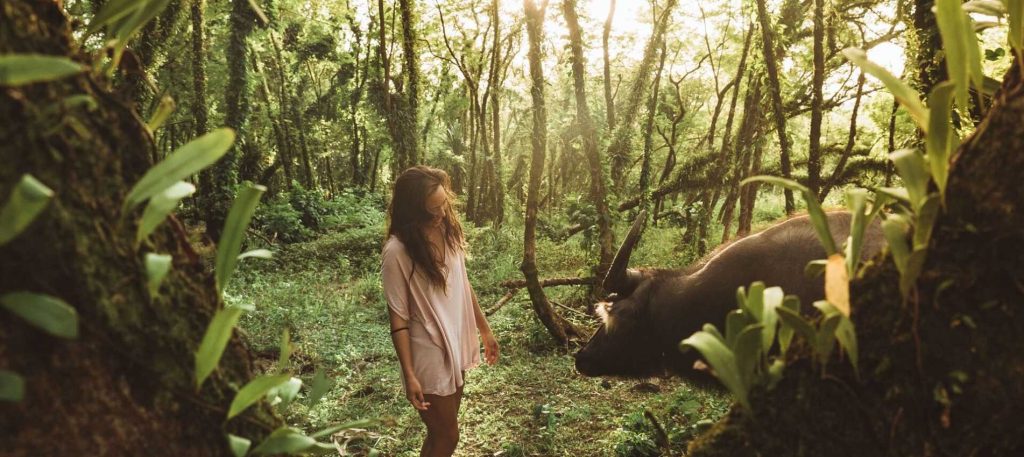
Flowers
Guam territorial flower is the Puti tai nobio, or Bougainvillea – also known as the paper flower. It is a thorny, year-round plant that produces brilliant colors of red, pink, purple, orange and white, and it is usually spread through vines and propagated through cuttings.
Guam is home to thousands of flower species typically found in the tropics, among the most popular are the plumeria, hibiscus, cup-of-gold, and dozens of beautiful orchids.
Other shrubs include varieties of bromeliads, hedge flowers, gingers and birds of paradise.
Flowering trees include the flame tree, allamanda, perfume tree and a wealth of others in every color of the rainbow. Guam’s tropical climate also makes it a perfect environment to grow ornamental house plants, cactuses and water flowers.

Fruits
While Guam imports many of the popular fruits that are standard in mainland groceries, air shipments ensure an abundance of fruits such as strawberries, oranges, apples, pears, nectarines, grapes and peaches. But options abound for dozens of local fruits, many of which are available year round. Guam’s rich soils are ripe for all types of melons, from honeydews, cantaloupe, watermelon varieties and even the mini melon known as the pipinu. Guam’s people love their citrus fruits too, and have a variety to select from: green lemon, local lime, lemonchina, clamansi, tangerines, green oranges and pumelos to name a few. There are many fruit tree varieties as well, from bananas to guavas, star apples, star fruits, santol, sineguelas, mountain apples, gooseberries, mulberries, mansanita, mango, avocado, atis, breadfruit, soursop, jackfruit and dozens more.
There are plants that produce sweet-smelling flowers and trees with succulent fruit. The perfumed aroma of plumeria, ginger, and jasmine permeates the air, and Guam’s territorial flower, the bougainvillea (puti tai nobio) blooms in many hues, lending color and form to the island’s landscape. Papayas, bananas, coconuts, breadfruit, mangoes, guavas, mountain apples, limes, and tangerilles flourish in the island’s ideal tropical climate.

Trees
Guam territorial tree: is the ifit, or ifil (Intsia Bijuga), and has a proliferation of coconut and other palms, ornamental and betel nut trees and countless acres of tangan tangan – a hardwood, easily grown tree useful for building and firewood.
Among the largest of Guam’s trees are the monkeypod, which would normally tower over all and provide a wealth of shade, save for the destruction of typhoons over the years.
Guam tropical forests are also home to ironwood pines and other conifers, trees with medicinal uses, ornamental trees, pandanus, hardwoods, softwoods and more, all of which play an instrumental role in Guam’s ecology.

Wildlife
Despite its isolation from major land masses, Guam has a number of interesting forms of animal life. Introduced deer and wild pigs inhabit jungle areas, as well as domesticated Carabao, or water buffalo, that can be seen lounging in cool streams on sultry days. We have shorebirds, such as the American Golden Plover, Gray-tailed Tattlers, and the Mongolian Dotteral. Rare and beautiful birds, such as the rose-crowned fruit dove, king fishers, and the Guam Rail, are endangered species. Catch a glimpse of the Mariana Swiftlet or the Mariana Mallard. Other native birds of Guam include the Mariana Fruit Dove and the Micronesian Megapode. Wild chickens make every neighborhood their home, and their early morning cries serve as alarm clock for many island residents. Enjoy more paintings by H. Douglas Pratt of Guam’s seabirds, shorebirds and waterbirds, as well as forest birds and land birds. Small, harmless lizards called geckos, blue-tailed skinks, and chameleons patrol our homes and gardens, searching for insects. Occasionally, monitor lizards known locally as hilitai, can be seen darting across roads, especially in the northern part of the island. Despite their popularity on the dinner table, the endangered fruit bats (fanihi) still dwell in caves in the northern tip of the island, though in greatly reduced numbers. Coconut crabs (ayuyu) prowl the grounds at night. Exotic African land snails leave silvery trails on garden paths and multicolored butterflies flutter from one exotic flower to another. Although Guam has a tremendous amount of fauna diversity, the non-poisonous brown tree snake, introduced to the island sometime after the Second World War by cargo ships has become an unwelcomed predator and pest. According to biologists, these brown tree snakes indigenous to Papua New Guinea and the Solomon Islands have virtually eliminated many bird species. The government has spent millions of dollars in attempts to eradicate the pest, and it looks as though it is beginning to work.